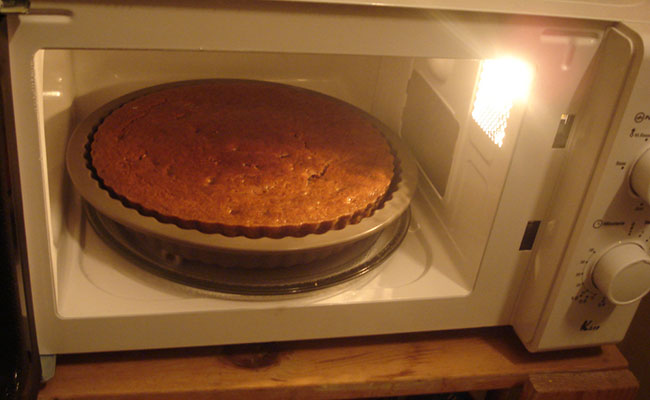Baking a cake in a microwave oven can be a quick and convenient way to enjoy a homemade treat. While many believe that only convection microwaves are suitable for baking, the truth is that both convection and non-convection microwaves can help you create delicious cakes. Convection microwaves utilise a fan to circulate hot air, ensuring even baking, while non-convection models rely solely on microwave radiation for faster cooking.
In this guide, we’ll show you how to bake a cake in both types of microwave ovens, ensuring a perfect, fluffy result whether you’re using convection or not!
Bake with Convection
Convection microwaves combine the power of microwaves with a fan to circulate hot air, allowing for even cooking and baking. This method mimics the functionality of a traditional oven, making it ideal for baking cakes. Here’s how you can bake a cake in a convection microwave:
-
Preheat the Microwave: Just like with a regular oven, preheat the convection microwave to the desired temperature (usually around 180°C or 350°F).
-
Prepare the Batter: Mix your cake ingredients as per the recipe. Pour the batter into a microwave-safe cake tin or dish.
-
Baking Time: Place the tin in the microwave and set the timer according to the recipe’s guidelines. Usually, it takes around 20-30 minutes for a cake to bake in a convection microwave, but this can vary based on the size and thickness of the cake.
-
Check for Doneness: After the baking time is complete, check if the cake is fully baked by inserting a toothpick into the centre. If it comes out clean, your cake is ready.
-
Cool and Serve: Let the cake cool for a few minutes before serving. Enjoy!
Bake without Convection


While you can absolutely bake a cake in microwave oven without convection setting, there are some things you need to be aware of for the best results. It’s important that you understand how the heating process works in a microwave. Before baking a cake in a Normal Microwave oven, we must understand the cycle behind the heating process in the microwave. The typical microwave doesn’t have temperature levels to set. It just has the power levels to set. For the most part, the selection of a microwave depends on its wattage. So, power levels speak to the measure of wattage that needs to be taken by the microwave. The power levels of a microwave are generally 10% to 100%. The power levels might differ from one microwave to another.
There are different ways to represent power levels: It might be like 10%,20%,30%… .100%, Or, numbering representation like 1,2,3,… .10 or 10,20,30… .100. Maybe a normal representation like extremely low, low, medium, medium-high, high.
Now, let’s have a look at the process of baking a cake by setting up the power levels.
Process to Bake a Cake in a Microwave Oven without Convection
Baking a cake in a non-convection microwave is simpler and faster, but it requires a slightly different approach since there’s no hot air circulation. Instead, the microwave uses electromagnetic waves to heat and cook the cake. Here’s a step-by-step guide to baking a cake in a non-convection microwave:
-
Prepare the Batter: Start by mixing the cake batter as per your recipe. Ensure the batter is smooth and lump-free for a light and fluffy cake.
-
Choose the Right Microwave-Safe Dish: Select a microwave-safe bowl or cake tin. A glass or ceramic dish works well as it allows the heat to distribute evenly. Avoid using metal pans, as they can interfere with the microwave’s functioning.
-
Grease the Dish: Lightly grease the microwave-safe dish with butter or oil, or line it with parchment paper to prevent the cake from sticking.
-
Set the Microwave Power Level: Unlike convection microwaves, non-convection microwaves don’t require preheating. Set the microwave to medium or high power (depending on your microwave’s wattage) to get the best results.
-
Baking Time: Place the dish in the microwave and set the timer for around 5 to 7 minutes. Cooking times can vary, so start with 5 minutes and check the cake. If it needs more time, continue microwaving in short intervals of 1 minute until the cake is cooked.
-
Check for Doneness: Insert a toothpick into the centre of the cake. If it comes out clean, the cake is ready. If the toothpick comes out with batter on it, microwave the cake for a little longer.
-
Cool and Serve: Let the cake cool in the dish for a few minutes before transferring it onto a wire rack to cool completely. Once cooled, you can frost and decorate your cake as desired.
Is It Necessary to Have a Convection Microwave for Baking?
You can prepare a cake in the standard heating mode if your microwave does not include a convection setting. You should use microwave-safe glass cookware instead of a steel rack. It requires approx 5 to 8 minutes to bake a cake at the standard temperature. Therefore, pay attention to the timings; otherwise, the texture may alter.
But, if you have a microwave with the convection mode on, at that point, 180 degrees Celcius is the temperature at which you bake a cake. But in case you don’t have a convection mode in your microwave at that point, you need to set the power at 100%, i.e. power level 10.
Microwave vs. Conventional Oven: What’s the Difference?
Many people are often confused between using a microwave and a traditional oven for baking. Here’s a quick comparison:
Microwave:
Microwave oven, commonly known as microwave, uses electromagnetic waves to generate heat, which quickly heats up the food. In a standard microwave, the heat is applied directly to the food, cooking it from the inside out. The process is faster than in a conventional oven and doesn’t require preheating. However, because there is no air circulation (unless using a convection microwave), the texture and browning can be different from a traditional oven-baked cake. Microwaves are particularly useful for quick fixes—think mug cakes or reheating leftovers. When baking in a microwave, recipes often require adjustments, such as shorter cooking times and specific microwave-safe containers.
Conventional Oven:
A conventional oven works by heating the air inside, which then surrounds and cooks the food. The heat is even and steady, which makes it perfect for baking. Ovens typically take longer to preheat and bake, but the results are often more consistent when it comes to texture and browning. This method allows for better control over the baking process, offering the right balance between moisture and crispness. Additionally, conventional ovens can accommodate larger batches, making them a go-to choice for professional bakers or those preparing for special occasions.
So, what’s the key takeaway?
While a conventional oven may give you a more traditional cake, the use of microwave oven for baking is not any less effective. It can still bake delicious sweet treats with the right technique. The key is understanding your microwave’s power settings and baking with attention to time. You don’t need to fret over not having a convection setting anymore—we’ve given you the ultimate solution to craft a perfect cake in your microwave!
If you don’t feel like going through all the baking steps, simply order cake online and enjoy! After all, celebrations aren’t complete without cake. Whether you bake it yourself or get one from the outside, a baked delight will surely make the occasion more memorable and enjoyable!





